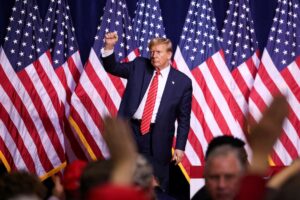Sell in May before Trump’s big comeback day
Political upheaval in the US and UK points to a tumultuous year for voters and traders
In the City, they’re already talking of it as a “nine-month year”. There’s so much uncertainty coming in the last quarter of 2024 that they’re getting their business done early, battening down the hatches from September onwards.
Both the biggest financial markets will be in the grip of political upheaval. In the UK, if Rishi Sunak has not called an early general election we will be heading towards one, most likely in November.
It’s possible he will go soon, in May, to seek the national vote first, before the local elections and a probable bloodbath for the Tories. June could well see Sunak immersed in negativity, fighting to explain the locals catastrophe and save his leadership. July is the summer and the onset of annual holidays. Then it’s autumn, and almost certainly a date after the completion of the party conference season.
Even if Sunak opted for May, it would still be towards the end of the year when the ramifications were becoming apparent,
that, if the polls are correct, a new, Labour government would be bedding in – with all the turmoil, after 14 years of Tory rule, that will bring.
Meanwhile, in the US it looks as thoughPresident Joe Biden and Donald Trump will go head to head again, a rematch of their contest that ended in near civil insurrection. There, the stakes could not be higher – increasing the probability of a national schism in the event of another anticipated close battle.
Add to the mix ballots occurring elsewhere in the world, a continuing war in Ukraine (there seems little prospect of that ending in the near future), and trauma in Gaza and the anniversary of the Hamas attack on Israel, and the stage is set fair for a turbulent post-summer.
Rather than face volatility which makes decision-making nigh on impossible, companies and their banking advisers have chosen to move now.
They’re bringing forward their fund-raising, not wishing to wait until later in the year when they would otherwise have gone. The result is a stampede of bond issues, worth $606 billion, a two-fifths increase on the same period last year, according to LSEG data. It also marks the highest tally since 1990.
The lowest spreads in a long time, marking the difference between US corporate debt yields and the yields on government bonds, have also influenced their thinking.
The Viv index, regarded as an indicator of fear as it collates expectations of swings in the S&P 500, is also suggesting an autumn roller-coaster.
Companies are issuing debt against a backdrop of greater economic health. It may seem contradictory to say they are going now to avoid uncertainty later, so the political landscape is queasy, yet the economic one is the most solid it’s been for a while.


